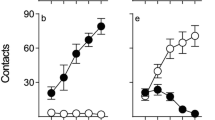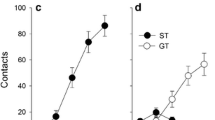Abstract
Rationale
Nicotine (NIC) potently increases operant responding for non-NIC reinforcers, and this effect may depend on drug-mediated increases in incentive motivation. According to this hypothesis, NIC should also potently increase approach to Pavlovian-conditioned stimuli associated with rewards.
Objective
The present studies explored the effects of NIC on Pavlovian-conditioned approach responses.
Method
To do so, liquid dippers were used to deliver an unconditioned stimulus (US; 0.1 ml sucrose) after presentation of a conditioned stimulus (CS; 30 s illumination of a stimulus light)—both the CS and US were presented in receptacles equipped to monitor head entries.
Results
In experiment 1, the CS and US were presented in the same receptacle, but NIC pretreatment (0.4 mg/kg base) did not increase conditioned approach responses. Delivery of the sucrose US was then shifted to receptacle in a different location. All rats learned to approach the new US location (goal-tracking) at similar rates. Approach to the CS receptacle (sign-tracking) declined for saline-pretreated rats, but NIC pretreatment increased sign-tracking. In experiment 2, NIC pretreatment increased sign-tracking when the CS and US were spatially separated during acquisition. In experiment 3, NIC pretreatments were replaced with saline, but the effect of NIC persisted for an additional 24 test sessions.
Conclusion
The findings suggest that NIC increases incentive motivation and that this effect is long-lasting, persisting beyond the pharmacological effects of NIC.






Similar content being viewed by others
References
Anderson RI, Spear LP (2011) Autosha** in adolescence enhances sign-tracking behavior in adulthood: impact on ethanol consumption. Pharmacol Biochem Behav 98:250–260
Berridge KC, Robinson TE (1998) What is the role of dopamine in reward: hedonic impact, reward learning, or incentive salience? Brain Res Brain Res Rev 28:309–369
Besheer J, Palmatier MI, Metschke DM, Bevins RA (2004) Nicotine as a signal for the presence or absence of sucrose reward: a Pavlovian drug appetitive conditioning preparation in rats. Psychopharmacology 172:108–117
Bevins RA, Palmatier MI (2004) Extending the role of associative learning processes in nicotine addiction. Behav Cogn Neurosci Rev 3:143–158
Brown PL, Jenkins HM (1968) Auto-sha** of the pigeon's key-peck. J Exp Anal Behav 11:1–8
Caggiula AR, Donny EC, Palmatier MI, Liu X, Chaudhri N, Sved AF (2009) The role of nicotine in smoking: a dual-reinforcement model. Nebr Symp Motiv 55:91–109
Chaudhri N, Caggiula AR, Donny EC, Booth S, Gharib M, Craven L, Palmatier MI, Liu X, Sved AF (2006a) Operant responding for conditioned and unconditioned reinforcers in rats is differentially enhanced by the primary reinforcing and reinforcement-enhancing effects of nicotine. Psychopharmacology 189:27–36
Chaudhri N, Caggiula AR, Donny EC, Palmatier MI, Liu X, Sved AF (2006b) Complex interactions between nicotine and nonpharmacological stimuli reveal multiple roles for nicotine in reinforcement. Psychopharmacology 184:353–366
Cohen C, Perrault G, Griebel G, Soubrie P (2005) Nicotine-associated cues maintain nicotine-seeking behavior in rats several weeks after nicotine withdrawal: reversal by the cannabinoid (CB1) receptor antagonist, rimonabant (SR141716). Neuropsychopharmacology 30:145–155
DiFeliceantonio AG, Berridge KC (2012) Which cue to ‘want’? Opioid stimulation of central amygdala makes goal-trackers show stronger goal-tracking, just as sign-trackers show stronger sign-tracking. Behav Brain Res 230:399–408
Dion AM, Reichel CM, Bevins RA (2011) Sign- vs. goal-tracking in a feature positive discrimination task with nicotine: importance of spatial location of the conditional stimulus. Behav Brain Res 218:341–345
Donny EC, Chaudhri N, Caggiula AR, Evans-Martin FF, Booth S, Gharib MA, Clements LA, Sved AF (2003) Operant responding for a visual reinforcer in rats is enhanced by noncontingent nicotine: implications for nicotine self-administration and reinforcement. Psychopharmacology 169:68–76
Doremus-Fitzwater TL, Spear LP (2011) Amphetamine-induced incentive sensitization of sign-tracking behavior in adolescent and adult female rats. Behav Neurosci 125:661–667
Farwell B, Ayres JJ (1979) Stimulus-reinforcer and response-reinforcer relations in the control of conditioned appetitive headpoking (goal tracking) in rats. Learn Motiv 10:295–312
Flagel SB, Watson SJ, Akil H, Robinson TE (2008) Individual differences in the attribution of incentive salience to a reward-related cue: influence on cocaine sensitization. Behav Brain Res 186:48–56
Harrod SB, Lacy RT, Morgan AJ (2012) Offspring of prenatal IV nicotine exposure exhibit increased sensitivity to the reinforcing effects of methamphetamine. Front Pharmacol 3:116
Hearst E, Jenkins HM (1974) Sign-tracking: the stimulus–reinforcer relation and directed action. Austin: Psychonomic Society
Hogarth L, Duka T (2006) Human nicotine conditioning requires explicit contingency knowledge: is addictive behaviour cognitively mediated? Psychopharmacology (Berl) 184:553–566
Hogarth L, Dickinson A, Duka T (2010) The associative basis of cue-elicited drug taking in humans. Psychopharmacology (Berl) 208:337–351
Lacy RT, Hord LL, Morgan AJ, Harrod SB (2012) Intravenous gestational nicotine exposure results in increased motivation for sucrose reward in adult rat offspring. Drug Alcohol Depend 124:299–306
Le Foll B, Goldberg SR (2006) Nicotine as a typical drug of abuse in experimental animals and humans. Psychopharmacology (Berl) 184:367–381
Olausson P, Jentsch JD, Taylor JR (2003) Repeated nicotine exposure enhances reward-related learning in the rat. Neuropsychopharmacology 28:1264–1271
Olausson P, Jentsch JD, Taylor JR (2004a) Nicotine enhances responding with conditioned reinforcement. Psychopharmacology 171:173–178
Olausson P, Jentsch JD, Taylor JR (2004b) Repeated nicotine exposure enhances responding with conditioned reinforcement. Psychopharmacology 173:98–104
Palmatier MI, Peterson JL, Wilkinson JL, Bevins RA (2004) Nicotine serves as a feature-positive modulator of Pavlovian appetitive conditioning in rats. Behav Pharmacol 15:183–194
Palmatier MI, Evans-Martin FF, Hoffman A, Caggiula AR, Chaudhri N, Donny EC, Liu X, Booth S, Gharib M, Craven L, Sved AF (2006) Dissociating the primary reinforcing and reinforcement-enhancing effects of nicotine using a rat self-administration paradigm with concurrently available drug and environmental reinforcers. Psychopharmacology (Berl) 184:391–400
Palmatier MI, Liu X, Caggiula AR, Donny EC, Sved AF (2007a) The role of nicotinic acetylcholine receptors in the primary reinforcing and reinforcement-enhancing effects of nicotine. Neuropsychopharmacology 32:1098–1108
Palmatier MI, Liu X, Matteson GL, Donny EC, Caggiula AR, Sved AF (2007b) Conditioned reinforcement in rats established with self-administered nicotine and enhanced by noncontingent nicotine. Psychopharmacology 195:235–243
Palmatier MI, Matteson GL, Black JJ, Liu X, Caggiula AR, Craven L, Donny EC, Sved AF (2007c) The reinforcement enhancing effects of nicotine depend on the incentive value of non-drug reinforcers and increase with repeated drug injections. Drug Alcohol Depend 89:52–59
Palmatier MI, Liu X, Donny EC, Caggiula AR, Sved AF (2008) Metabotropic glutamate 5 receptor (mGluR5) antagonists decrease nicotine seeking, but do not affect the reinforcement enhancing effects of nicotine. Neuropsychopharmacology 33:2139–2147
Palmatier MI, O'Brien LC, Hall MJ (2012) The role of conditioning history and reinforcer strength in the reinforcement enhancing effects of nicotine in rats. Psychopharmacology (Berl) 219:1119–1131
Paterson NE, Balfour DJ, Markou A (2008) Chronic bupropion differentially alters the reinforcing, reward-enhancing and conditioned motivational properties of nicotine in rats. Nicotine Tob Res 10:995–1008
Pithers RT (1982) The roles of S-R contiguity and reinforcement in autosha** and omission responding. Aust J Psychol 34:1–16
Raiff BR, Dallery J (2008) The generality of nicotine as a reinforcer enhancer in rats: effects on responding maintained by primary and conditioned reinforcers and resistance to extinction. Psychopharmacology 201:305–314
Reid AK (2009) Resistance to change within heterogeneous response sequences. J Exp Psychol Anim Behav Process 35:293–311
Robinson TE, Berridge KC (1993) The neural basis of drug craving: an incentive-sensitization theory of addiction. Brain Res Brain Res Rev 18:247–291
Robinson TE, Flagel SB (2009) Dissociating the predictive and incentive motivational properties of reward-related cues through the study of individual differences. Biol Psychiatry 65:869–873
Thiel KJ, Sanabria F, Neisewander JL (2009) Synergistic interaction between nicotine and social rewards in adolescent male rats. Psychopharmacology (Berl) 204:391–402
Timberlake W (1993) Behavior systems and reinforcement: an integrative approach. J Exp Anal Behav 60:105–128
Tomie A, Grimes KL, Pohorecky LA (2008) Behavioral characteristics and neurobiological substrates shared by Pavlovian sign-tracking and drug abuse. Brain Res Rev 58:121–135
Uslaner JM, Acerbo MJ, Jones SA, Robinson TE (2006) The attribution of incentive salience to a stimulus that signals an intravenous injection of cocaine. Behav Brain Res 169:320–324
Uslaner J, Dell'Orco J, Pevzner A, Robinson T (2008) The influence of subthalamic nucleus lesions on sign-tracking to stimuli paired with food and drug rewards: facilitation of incentive salience attribution? Neuropsychopharmacology 33:2352–2361
Weaver MT, Geier CF, Levin ME, Caggiula AR, Sved AF, Donny EC (2012) Adolescent exposure to nicotine results in reinforcement enhancement but does not affect adult responding in rats. Drug Alcohol Depend 125:307–312
Wyvell CL, Berridge KC (2000) Intra-accumbens amphetamine increases the conditioned incentive salience of sucrose reward: enhancement of reward “wanting” without enhanced “liking” or response reinforcement. J Neurosci 20:8122–8130
Acknowledgments
The research was conducted at Kansas State University and all of the protocols and procedures were approved by the Kansas State University Institutional Animal Care and Use Committee (Animal Welfare Assurance #: A3609-01). We thank Dr. Rick Bevins for his comments on a previous version of this manuscript. We thank Dr. Matt McBee for assistance with data analysis. We thank Jessica Jones, Ryan Floyd, Skyler Gross, and Taylor Montgomery for their assistance conducting these studies. The studies were partially supported by the Johnson Center for Basic Cancer Research at Kansas State University (SA Jones) and NIH grant DA-24801 (MI Palmatier).
Author information
Authors and Affiliations
Corresponding author
Rights and permissions
About this article
Cite this article
Palmatier, M.I., Marks, K.R., Jones, S.A. et al. The effect of nicotine on sign-tracking and goal-tracking in a Pavlovian conditioned approach paradigm in rats. Psychopharmacology 226, 247–259 (2013). https://doi.org/10.1007/s00213-012-2892-9
Received:
Accepted:
Published:
Issue Date:
DOI: https://doi.org/10.1007/s00213-012-2892-9




